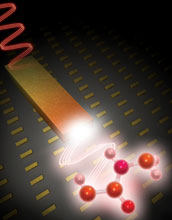Multimedia Gallery
Ultrasensitive Infrared Absorption Spectroscopy
Engineered rod-shaped, gold nanoparticle arrays localize infrared light at the particle tips and dramatically enhance molecular specific absorption signals of protein molecules.
More about this Image
By exploiting recent advances in nanophotonics and nanotechnology, a National Science Foundation-supported team of researchers, led by Hatice Altug of Boston University, has demonstrated an ultra-sensitive infrared (IR) absorption spectroscopy technique that can analyze minute amounts of proteins and other molecules. The technique may profoundly change the methodology of biomolecular studies and chart a new path to effective diagnostics and early treatment of complex diseases.
IR absorption spectroscopy uses infrared light to excite the bonds that connect atoms within molecules, causing the molecules to vibrate at a specific resonant frequency. By examining what frequencies of light are absorbed by the molecules, scientists can determine what type of bonds hold them together, and thus identify the molecule.
Because absorption signals are often weak, conventional IR spectroscopy requires large samples of target molecules in many layers. To overcome this limitation, the research team used arrays of tiny gold nanoparticles as highly efficient nano-antennas and amplified the signals of individual protein molecules more than 100,000 times. The team obtained vibrational signatures from bio-samples as thin as a single layer of protein. This advancement is fundamentally important for biochemistry, because it allows the sensitive study of molecular structures and biological functions of extremely small quantities of proteins. [Research supported by National Science Foundation grants SGER 08-49603 and CAREER 09-54790.] (Date of Image: May 2009)
Credit: Courtesy of Hatice Altug of Boston University and Michael Ekins
Images and other media in the National Science Foundation Multimedia Gallery are available for use in print and electronic material by NSF employees, members of the media, university staff, teachers and the general public. All media in the gallery are intended for personal, educational and nonprofit/non-commercial use only.
Images credited to the National Science Foundation, a federal agency, are in the public domain. The images were created by employees of the United States Government as part of their official duties or prepared by contractors as "works for hire" for NSF. You may freely use NSF-credited images and, at your discretion, credit NSF with a "Courtesy: National Science Foundation" notation.
Additional information about general usage can be found in Conditions.
Also Available:
Download the high-resolution JPG version of the image. (3 MB)
Use your mouse to right-click (Mac users may need to Ctrl-click) the link above and choose the option that will save the file or target to your computer.



